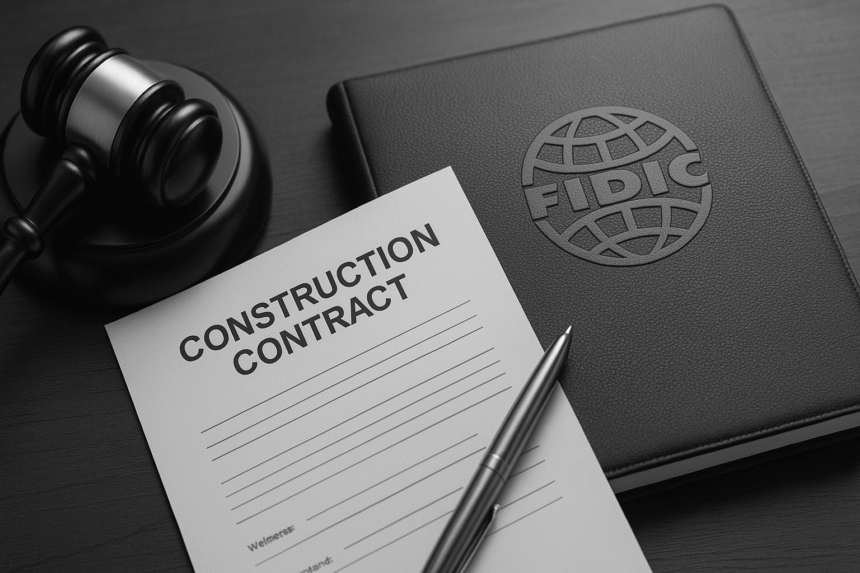How to Structure a Construction Contract Under FIDIC
Introduction: Why FIDIC Contracts Matter
Many construction professionals face confusion when drafting or negotiating contracts, especially in international projects. Poorly structured contracts can lead to project delays, cost overruns, or even legal disputes. The FIDIC suite of contracts (developed by the International Federation of Consulting Engineers) provides a widely accepted and balanced framework for construction agreements.
This guide will walk you through how to structure a construction contract using FIDIC standards—whether you’re a consultant, contractor, developer, or legal advisor.
Who This Is For / When to Use It
This guide is ideal for:
- Construction companies working on international or government-funded projects
- Project owners needing standardized and enforceable terms
- Legal professionals advising in the engineering or construction sectors
- Consultants drafting contracts based on FIDIC
Use this guide when:
- Starting a new infrastructure or construction project
- Dealing with public tenders
- Managing multi-country engineering ventures
Step-by-Step Guide to Structuring a FIDIC-Based Construction Contract
Step 1: Choose the Right FIDIC Contract Type
FIDIC offers several forms, each tailored for a specific scenario:
- Red Book: For building and engineering works designed by the employer
- Yellow Book: For design-build contracts (contractor designs and executes)
- Silver Book: For turnkey projects with higher contractor risk
- Green Book: For short-term or small contracts
- Gold Book: For design-build-operate contracts
Why it matters: Selecting the wrong form can shift risk unfairly or leave out essential clauses.
Step 2: Use the General Conditions as a Base
FIDIC contracts come with standardized General Conditions (Part I), which cover:
- Definitions and interpretations
- The role of the Engineer
- Employer and contractor obligations
- Extensions of time
- Payments and variations
How to use: Do not change Part I unless absolutely necessary. Instead, use Part II (Special Conditions) for modifications.
Step 3: Draft the Particular Conditions (Part II)
This section allows you to adapt the contract to local laws and project-specific needs. Focus on:
- Governing law and dispute resolution method (court or arbitration)
- Site access dates and working hours
- Milestone schedules or completion deadlines
- Insurance obligations
- Currency and payment terms
Tip: Be precise. Vague conditions in Part II often lead to disputes.
Step 4: Include Key Annexes and Appendices
A well-structured FIDIC contract should include attachments such as:
- Appendix to Tender: A table that summarizes financial and administrative terms
- Specifications and Drawings
- Bill of Quantities (BoQ)
- Performance Security and Advance Payment Guarantees
- Program (Construction Schedule)
Step 5: Align the Contract with Local Legal Requirements
Some jurisdictions require:
- Official language translations
- Stamping and registration
- Local insurance carriers or banks for bonds
Practical tip: Consult local counsel or a FIDIC-trained professional to ensure compliance.
Step 6: Define Clear Roles and Communication Protocols
A typical FIDIC contract outlines the role of the Engineer as a contract administrator. Make sure to:
- Specify how instructions are issued (e.g., written notice, site instructions)
- Include timeframes for responses or approvals
- Clarify delegation rules and approval rights
Mistake to avoid: Leaving the Engineer’s authority vague can result in confusion or unauthorized decisions.
Step 7: Draft Dispute Resolution Clauses Wisely
FIDIC recommends a three-tier approach:
- Engineer’s Decision (initial dispute resolution)
- Dispute Adjudication/Avoidance Board (DAB or DAAB)
- Arbitration (under ICC Rules or agreed forum)
Be sure to clearly define:
- Timeframes to raise and respond to claims
- Binding vs. non-binding stages
- Institutional rules for arbitration
Mini Case Study: Structuring a Contract in the Gulf Region
A UAE-based infrastructure firm used the Yellow Book for a water treatment project. The project was cross-border, involving a local developer and an Italian engineering consultant.
By customizing Part II, they aligned payment milestones with local bank transfer procedures and added a mandatory Arabic translation for enforcement purposes. They also appointed a DAAB early to avoid delays.
Outcome: Disputes were avoided, and the project finished one month ahead of schedule.
Closing Thoughts + CTA
A well-structured FIDIC construction contract balances risk, increases transparency, and supports smoother project execution. Whether you’re a contractor or project owner, taking the time to customize the agreement correctly is one of the best ways to reduce disputes.
Need help drafting or reviewing a FIDIC contract? Book a call with Muhammad Helmy, the construction law expert.



Leave a Reply